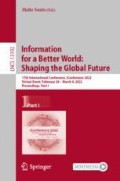Abstract
Facial recognition technology (FRT) is now being introduced across various aspects of public life. However, the controversial nature of FRT and improper uses often generate critical concerns and even resistance. Research on human interactions with FRT has focused principally on individual-level usage in private spaces, tending not to capture in-situ, nuanced human-surveillance technology interactions. To address this gap, we investigated users’ lived experiences with a facial recognition system at a university in the United States, using semi-structured interviews. In this paper, we reported findings of participants’ first impressions and initial reactions to FRT, whether and why their attitudes changed afterwards, and how they evaluated the administration that made the deployment decision. We found that besides issues of privacy, data security, and possible bias, the participants highlighted the idea that FRT might deconstruct the nature of community and connections between people as well as resulting in mass surveillance. In evaluating the deployment decision, the participants perceived control of and transparency in the decision-making process, the accuracy and timeliness of the information, and respect accorded to users in the process as equal in importance to the technology itself. Our findings also point to organizational issues associated with the administration of FRT and offer insights into controversial technology deployment from an organizational justice perspective.
Access this chapter
Tax calculation will be finalised at checkout
Purchases are for personal use only
References
Durkin, E.: New York school district’s facial recognition system sparks privacy fears. The Guardian (2019)
Selwyn, N.: Digital lessons? Public opinions on the use of digital technologies in Australian schools (2019). https://www.monash.edu/data/assets/pdf_file/0008/1626236/Education-Futures-Research-Report-Digital-Lessons.pdf
Bhagavatula, R., Ur, B., Lacovino, K., Su, M.K., Cranor, L.F., Savvides, M.: Biometric authentication on iPhone and Android: usability, perceptions, and influences on adoption. Presented at the Workshop on Usable Security 2015, San Diego, CA (2015). https://ink.library.smu.edu.sg/sis_research/3967
Ellerbrok, A.: Playful biometrics: controversial technology through the lens of play. Sociol. Q. 52(4), 528–547 (2011). https://doi.org/10.1111/j.1533-8525.2011.01218.x
Lai, X., Rau, P.-L.P.: Has facial recognition technology been misused? A public perception model of facial recognition scenarios. Comput. Hum. Behav. 124, 106894 (2021). https://doi.org/10.1016/j.chb.2021.106894
Seng, S., Nasrullah Al-Ameen, M., Wright, M.: A first look into users’ perceptions of facial recognition in the physical world. Comput. Secur. 105, 102227 (2021). https://doi.org/10.1016/j.cose.2021.102227
Stark, L., Stanhaus, A., Anthony, D.L.: ‘I don’t want someone to watch me while I’m working’: gendered views of facial recognition technology in workplace surveillance. J. Assoc. Inf. Sci. Technol. 71(9), 1074–1088 (2020). https://doi.org/10.1002/asi.24342
Noble, S.U.: Algorithms of Oppression. New York University Press, New York (2018). https://doi.org/10.18574/9781479833641
Reilly, C.: Facial-recognition software inaccurate in 98% of cases, report finds. Cnet.com (2018). https://www.cnet.com/news/facial-recognition-software-inaccurate-in-98-of-metropolitan-police-cases-reports/
Buolamwini, J., Gebru, T.: Gender shades: intersectional accuracy disparities in commercial gender classification. In: Proceedings of the 1st Conference on Fairness, Accountability and Transparency, pp. 77–91 (2018). http://proceedings.mlr.press/v81/buolamwini18a.html?mod=article_inline
Hachim, E.K., Wechsler, H.: Face verification subject to varying (age, ethnicity, and gender) demographics using deep learning. J. Biom. Biostat. 7(323) (2016). https://doi.org/10.4172/2155-6180.1000323
Klare, B.F., Burge, M.J., Klontz, J.C., Vorder Bruegge, R.W., Jain, A.K.: Face recognition performance: role of demographic information. Proc. IEEE Trans. Inf. Forensics Secur. 6, 1789–1801 (2012). https://doi.org/10.1109/TIFS.2012.2214212
Allyn, B.: The computer got it wrong’: how facial recognition led to false arrest of black man. NPR (2020). https://www.npr.org/2020/06/24/882683463/the-computer-got-it-wrong-how-facial-recognition-led-to-a-false-arrest-in-michig
Hill, K.: Another arrest, and jail time, due to a bad facial recognition match. New York Times (2020). https://www.nytimes.com/2020/12/29/technology/facial-recognition-misidentify-jail.html
Akhtar, Z., Rattani, A.: A face in any form: new challenges and opportunities for face recognition technology. Computer 50(4), 80–90 (2017). https://doi.org/10.1109/MC.2017.119
Korshunov, P., Marcel, S.: Deepfakes: a new threat to face recognition? Assessment and detection (2018). https://arxiv.org/abs/1812.08685
Andrejevic, M., Selwyn, N.: Facial recognition technology in schools: critical questions and concerns. Learn. Media Technol. 45(2), 115–128 (2020). https://doi.org/10.1080/17439884.2020.1686014
Charmaz, K.: Constructing Grounded Theory, 2nd edn. SAGE Publications, Thousand Oaks (2014)
Wolfe, K., Bjornstad, D.J., Russell, M., Kerchner, N.D.: A framework for analyzing dialogues over the acceptability of controversial technologies. Sci. Technol. Hum. Values 27(1), 134–159 (2002). https://doi.org/10.1177/016224390202700106
Petrun, E.L., Iles, I., Roberts, H., Liu, B.F., Ackerman, G.: Diffusing controversial technology: barriers, incentives, and lessons learned. Rev. Commun. 15(2), 140–160 (2015). https://doi.org/10.1080/15358593.2015.1058410
Author information
Authors and Affiliations
Corresponding author
Editor information
Editors and Affiliations
Rights and permissions
Copyright information
© 2022 The Author(s), under exclusive license to Springer Nature Switzerland AG
About this paper
Cite this paper
Fu, H., Lyu, Y. (2022). Facial Recognition Interaction in a University Setting: Impression, Reaction, and Decision-Making. In: Smits, M. (eds) Information for a Better World: Shaping the Global Future. iConference 2022. Lecture Notes in Computer Science(), vol 13192. Springer, Cham. https://doi.org/10.1007/978-3-030-96957-8_29
Download citation
DOI: https://doi.org/10.1007/978-3-030-96957-8_29
Published:
Publisher Name: Springer, Cham
Print ISBN: 978-3-030-96956-1
Online ISBN: 978-3-030-96957-8
eBook Packages: Computer ScienceComputer Science (R0)

